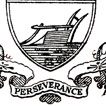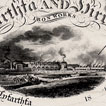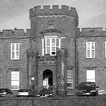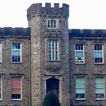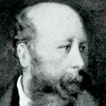The Glamorgan-Gwent Archaeological Trust Ltd.
Archaeology in Wales
The Crawshays and Cyfarthfa
Initially from Yorkshire, Richard Crawshay (1739-1810) was the most successful iron merchant of his day, his merchant house in London was established in 1763 and from here he imported iron from the Baltic. It was during this trade that he realised the potential for the British iron industry, if only the iron that could be produced here could match the high quality of the European imports.
He began his involvement in the iron of Merthyr Tydfil in 1777 when he became the merchant partner of Anthony Bacon, who was a major government supplier of ordnance from his iron foundry at Cyfarthfa Ironworks, established in the late 1760s. Following Bacon's death in 1786, Crawshay acquired the lease of Cyfarthfa. The successful conversion of cast iron to wrought iron with particular reference to refining was the main focus of iron making technology during the latter part of the eighteenth century and into the early nineteenth century. With a licence for Henry Cort's puddling process, Crawshay saw the possibility of producing the high quality iron for rolling that was in such demand. This did not happen immediately, and poor quality metal was being produced that was not evenly malleable and was even found to be peeling off mill hammers. Richard sent his son William Crawshay I (1764 – 1834) to oversee some of the experimentation that was being undertaken to resolve these problems. A solution was, however, developed (perhaps by Samuel Homfray at the neighbouring Penydarren Ironworks), involving an intermediate stage of melting the grey pig iron in an oxidising environment, followed by quenching the molten iron in a water-cooled trough to produce 'finers metal', a white cast iron. This revised process, subsequently known as 'refining' was adopted rapidly and by 1791 Crawshay was fully committed to conversion by refining and puddling.
Rapid expansion of Cyfarthfa followed between 1792 and 1796. However, the location of the enormous waterwheel powering the blowing engine for the Cyfartha furnaces prohibited easy expansion of the smelting operation after 1796. A temporary solution was found in a contract with neighbouring Dowlais Ironworks (majority owned by John Josiah Guest at this time) to supply Cyfarthfa with 2000 tons of pig iron per year from 1797 to 1802. A more permanent solution was the construction of a subsidiary works at Ynysfach in 1801 under the ownership of Richard Crawshay and a partner in the company, the celebrated engineer and foundry manager Watkin George. Ynysfach housed an enormous twin blast furnace and large casting house and two refinery furnaces to increase the feed of finer's metal to the Cyfarthfa puddling works. These were the first of the Cyfarthfa associated blast furnaces to be powered by a steam blast.
The high quality of the iron being produced at Cyfarthfa was brought to the attention of Admiral Nelson who visited Cyfarthfa Ironworks in 1802 to view the manufacture of both cannons and cannon balls for the naval battles of the day. After 1815, Cyfarthfa was restructured to permit expansion, with seven blast furnaces on that site by 1825. The reputation of Cyfarthfa spread across the world and in 1823 a representative of the Tsar of Russia (Alexander I) visited Cyfarthfa Ironworks to confirm a significant order of iron rails to be sent to Russia. By the 1830s capacity was again stretched, and so Ynysfach was further expanded in 1836, this time under the direction of William's son William Crawshay II. The expansion consisted of two new blast furnaces and four new refineries. The Cyfarthfa/Ynysfach works were later managed in an increasingly conservative way, and a lack of innovation caused them to fall behind their great rival, Dowlais, with the result that the works closed in 1874 whilst in the ownership of William II's son Robert Thompson Crawshay. It is likely that Cyfarthfa used refining until the very end, despite newer technologies being adopted in many other works in South Wales. Although Ynysfach briefly reopened in 1879, a complete closure of the Cyfarthfa operation was ordered in 1881, to enable its reconstruction as a steelworks, which opened in 1884 under the ownership of RT Crawshay's three sons who traded as the 'Crawshay Brothers'. Ynysfach was held in reserve – it did not open again.
During the First World War Ynysfach was specifically targeted by the Ministry of Munitions when the Director of Scrap wrote a letter dated 31 August 1917 drawing attention to the huge amounts of iron and steel lying around both the Cyfarthfa and Ynysfach sites.


